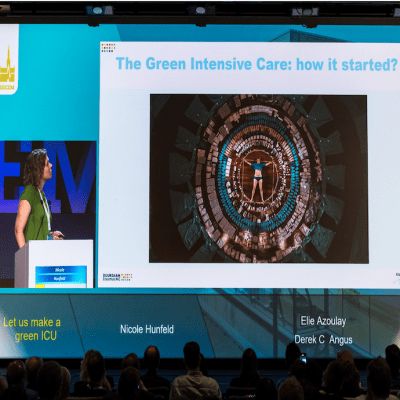Hyperthermia is a life-threatening complication in a small number of patients treated with neuropsychiatric drugs or who use recreational drugs. Philippe Hantson, MD, of the Louvain Centre for Toxicology and Applied Pharmacology, Belgium presented recommendations for treating patients with drug-induced hyperthermia at EUSEM18, the European Society of Emergency Medicine annual congress, which met in Glasgow this week.
Drug-induced hyperthermia is more often observed as a therapeutic accident than after an overdose—the dose does not make the risk. It has similar consequences to heatstroke, at least in the last stage. Hyperthermia differs from fever in that in hyperthermia thermoregulatory control mechanisms are impaired, disabled or overwhelmed. In fever they are intact.
The higher the temperature and the longer time at that temperature, the worse the prognosis. The critical temperature value is when it reaches 41.6 to 42° C from 45 minutes to 8 hours. At 43.5°C survival is less than 30 minutes, with death resulting from multiple organ failure.
The severity of the reaction is usually not dose-related, but the role of environmental conditions should not be underestimated.
Treatment is mainly supportive, with aggressive temperature control based on physical principles, eviction of the offending drug, myorelaxation, and, when indicated, more specific pharmacological agents that influence either central or peripheral mechanisms of thermoregulation. Benzodiazepines are effective in almost all cases of drug-induced hyperthermia.
Urgent cooling is probably more effective than any pharmalogical approach, said Hantsen. Althought there are no validated clinical studies of its use in drug-inducted hyperthermia, it is commonly used in patients who have had an out-of-hospital cardiac arrest. It should be induced with 30 mL/kg of iced (4°C) saline. To maintain cooling needs core plus external cooling using fan & ice and a cooling blanket.
Cooling is inexpensive adaptable in the ED and is speedy. The potential disadvantages are excessive cutaneous vasoconstriction and shivering limiting heat dissipation, patient discomfort and difficulties or monitoring or treatment, such as intubation or defibrillation.
1. Identify and stop the offending agent.
2. NSAIDs and acetaminophen are ineffective as they are not prostaglandin-mediated
Treat the symptoms in order to reduce heat production. If the patient is agitated, avoid medications that antagonise dopamine and acetylcholine transmission (this cover the major or recent antipsychotics). Instead use titrated doses of benzodiazepines (midazolam, diazepam) using endpoints control of psychomotor agitation and normalisation of vital signs. This is also effective for myoclonus and seizures.
If the patient has increased muscle tone, use a nondepolarizing agent for paralysis, with caution for underlying seizure activity. Neuromuscular blocks may be appropriate in some cases.
Drug-induced hyperthermia is more often observed as a therapeutic accident than after an overdose—the dose does not make the risk. It has similar consequences to heatstroke, at least in the last stage. Hyperthermia differs from fever in that in hyperthermia thermoregulatory control mechanisms are impaired, disabled or overwhelmed. In fever they are intact.
The higher the temperature and the longer time at that temperature, the worse the prognosis. The critical temperature value is when it reaches 41.6 to 42° C from 45 minutes to 8 hours. At 43.5°C survival is less than 30 minutes, with death resulting from multiple organ failure.
The severity of the reaction is usually not dose-related, but the role of environmental conditions should not be underestimated.
Treatment is mainly supportive, with aggressive temperature control based on physical principles, eviction of the offending drug, myorelaxation, and, when indicated, more specific pharmacological agents that influence either central or peripheral mechanisms of thermoregulation. Benzodiazepines are effective in almost all cases of drug-induced hyperthermia.
Cooling more effective
Urgent cooling is probably more effective than any pharmalogical approach, said Hantsen. Althought there are no validated clinical studies of its use in drug-inducted hyperthermia, it is commonly used in patients who have had an out-of-hospital cardiac arrest. It should be induced with 30 mL/kg of iced (4°C) saline. To maintain cooling needs core plus external cooling using fan & ice and a cooling blanket.
Cooling is inexpensive adaptable in the ED and is speedy. The potential disadvantages are excessive cutaneous vasoconstriction and shivering limiting heat dissipation, patient discomfort and difficulties or monitoring or treatment, such as intubation or defibrillation.
Pharmacological management
1. Identify and stop the offending agent.
2. NSAIDs and acetaminophen are ineffective as they are not prostaglandin-mediated
Treat the symptoms in order to reduce heat production. If the patient is agitated, avoid medications that antagonise dopamine and acetylcholine transmission (this cover the major or recent antipsychotics). Instead use titrated doses of benzodiazepines (midazolam, diazepam) using endpoints control of psychomotor agitation and normalisation of vital signs. This is also effective for myoclonus and seizures.
If the patient has increased muscle tone, use a nondepolarizing agent for paralysis, with caution for underlying seizure activity. Neuromuscular blocks may be appropriate in some cases.
Latest Articles
hyperthermia, drug-induced, cooling, European Society of Emergency Medicine, #EuSEM18
Hyperthermia is a life-threatening complication in a small number of patients treated with neuropsychiatric drugs or who use recreational drugs. Philippe Hantson, MD, of the Louvain Centre for Toxicology and Applied Pharmacology, Belgium presented recomm



























